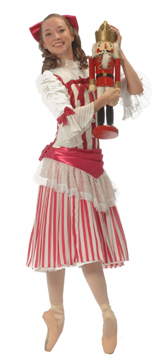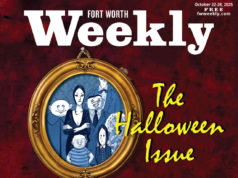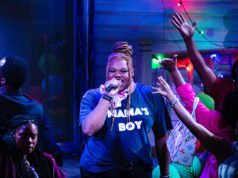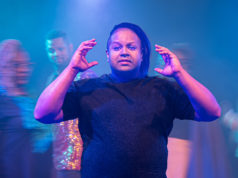 Beginning earlier this month, Texas Ballet Theater began a three-week run of the holiday staple at Bass Performance Hall. After wrapping up this Sunday, TBT will travel to Dallas and perform at State Fair Music Hall until Dec. 23. Metropolitan Classical Ballet put on four performances of its version in Arlington last week.
Beginning earlier this month, Texas Ballet Theater began a three-week run of the holiday staple at Bass Performance Hall. After wrapping up this Sunday, TBT will travel to Dallas and perform at State Fair Music Hall until Dec. 23. Metropolitan Classical Ballet put on four performances of its version in Arlington last week.
The two couldn’t be further apart in look and style, and contrast in the diverging productions gives a welcome freshness to the familiar Tchaikovsky classic. Some of the difference is budgetary. TBT has more resources to play with and brings out more bells and whistles. But the two versions also reflect the backgrounds and outlooks of the companies’ artistic directors.
TBT’s Ben Stevenson traces his ballet roots to the English school that evolved after World War II, influenced by émigré dancers from the old Saint Petersburg Imperial company. Their emphases were on lyric phrasing and purity of line. Alexander Vetrov, on the other hand, who heads MCB’s Russian repertory, grew up in the Moscow tradition as principal dancer with the Bolshoi Ballet. When the Communists moved their capital to Moscow, Russian ballet took on a bold, athletic look, full of power and passion to represent the new Soviet Union, as if to say that classical dance was no longer the plaything of decadent aristocrats.
The two styles were much in evidence last week in the Nutcracker’s crowning moment, the great pas de deux for the Sugar Plum Fairy and her Cavalier in the second act. While the outline of the original was there in both cases, TBT offered a gentle, refined view of the choreography. The duet was decidedly adagio, with Julie Gumbinner, TBT’s up-and-coming ballerina, a marvel of elegant phrasing and beautiful line. There is a knack to bringing this kind of dancing to life that Gumbinner is still working on. At times she was languid to the point of sleep-walking, moving slowly through the wonderful patterns without any inner warmth to light up the movement. Her partner was Lucas Priola, who gave steady support and danced his variations with understated assurance.
MCB took a Bolshoi view of the dance, with Olga Pavlova and Yevgeni Anfinogenov opening up in remarkable high style. In addition to the usual lifts, they included a killer one-arm sequence that never ceases to amaze when it appears. As the dancers run toward each other the ballerina jumps, her partner lifts her up, and in a sleight of hand rotates her 180 degrees. Suddenly she’s sitting forward overhead in the palm of his hand. With no tremor, no bobble, Anfinogenov calmly promenaded her around the stage. Pavlova’s lyric dancing was filled with a subdued vitality that erupted into the fastest and most cleanly executed fouette turns you’re likely to see, forcing conductor Ron Spigelman to double the music’s tempo to keep up.
The Nutcracker’s other extended duet, for the Snow Queen and Nutcracker Prince in the Kingdom of the Snow scene, was danced by veteran ballerina Enrica Guana Tseng for TBT, also partnered by Priolo. She brought verve and sparkle to the dance and altogether a satisfying look at the role. Tseng has blossomed into a major dancer since Stevenson took over the company.
MCB alters the winter scene in a change I’ve complained about but that worked better this year. Vetrov did away with the Snow Queen in this scene and instead had little Clara dance with the prince, which meant that the choreography was simplified to match a young dancer’s ability. Emily Maciejewski, still a high school student, danced Clara with growing maturity and a sense of style that bodes well for her future, offering more compensation for the missing Snow Queen than we’ve seen before.
Though Tchaikovsky’s score includes a boys’ choir, both productions made do with improvisation. Jack Buchkannan, leading the For Worth Symphony in the TBT pit, used synthesizers to replicate the vocal line, while Spigelman assigned the duty to the trumpets.
Vetrov has done a heroic job of streamlining MCB’s opening party scene to match his limited forces and rehearsal time. The youngsters disappeared and returned as needed, and the guests’ farewell was cut altogether. Andrei Prikhodko’s portrayal of the wizard Drosselmeyer could have used a little more mystery and touch of menace, but the scene flowed naturally and quickly carried us into the fantasy sequences.
TBT’s party segment was a symphony of individual mini-dramas, with three generations of family and guests filling the stage to overflowing. There isn’t a director alive — in theater, opera, or ballet — who manages crowd scenes better than Stevenson. Each person is a fully developed character interacting with those around him. And the whole comes together as a unified stage picture.
Regional dance companies usually don’t have the luxury of performing the same ballets year after year, of getting to know a piece inside out and finding new possibilities in the choreography. The exception is Nutcracker, and dancers in both companies here seemed not just comfortable but invigorated by exploring the unique holiday ballet. Even the two corps were relaxed and joyous. Watching them was like welcoming home old friends.











